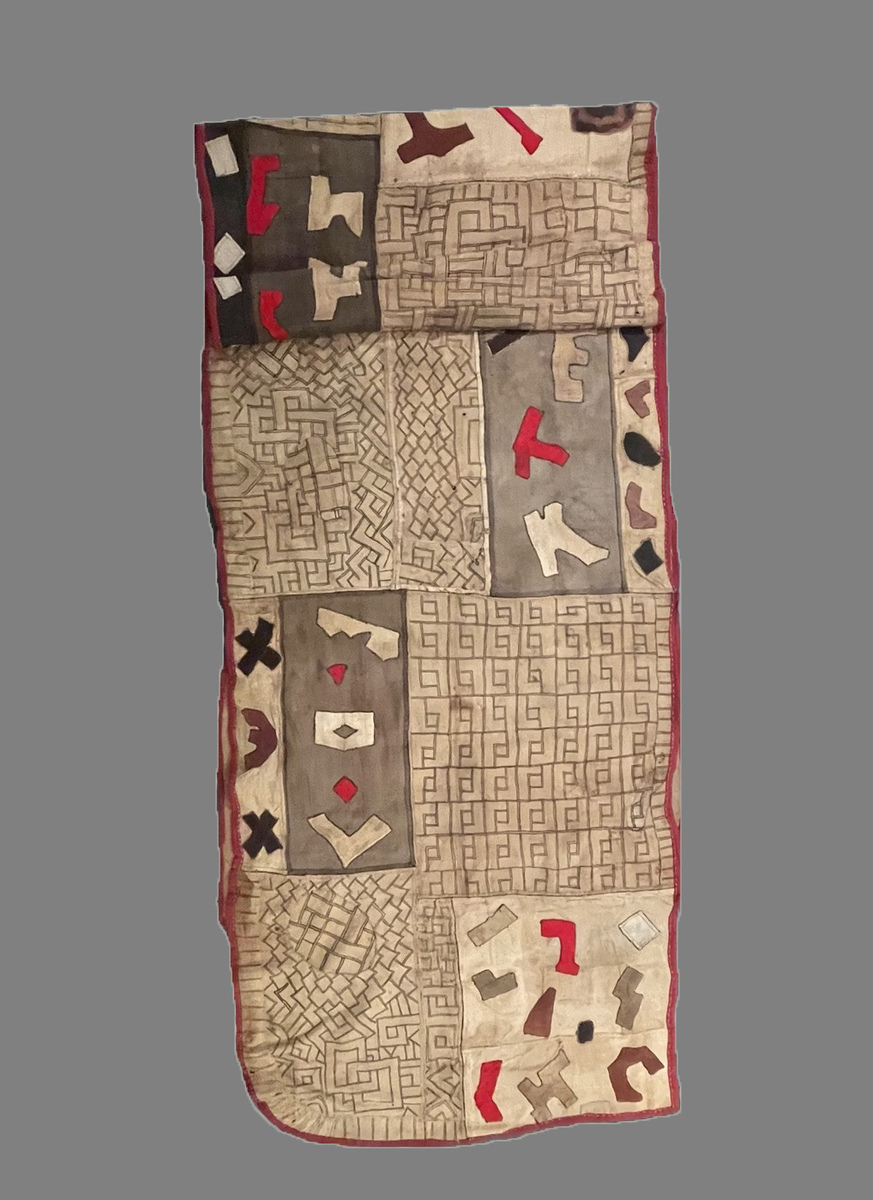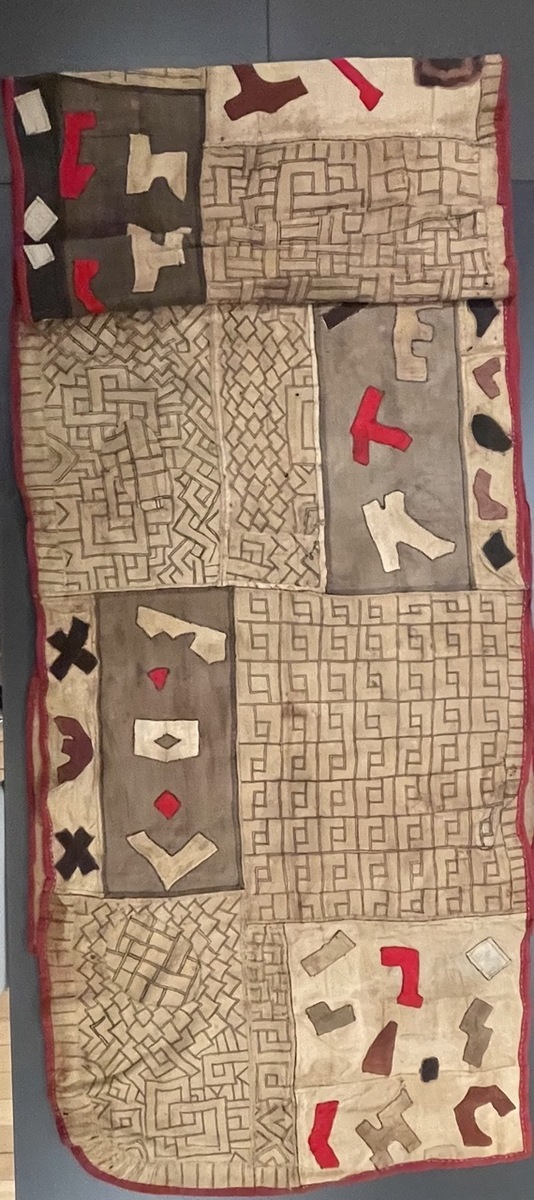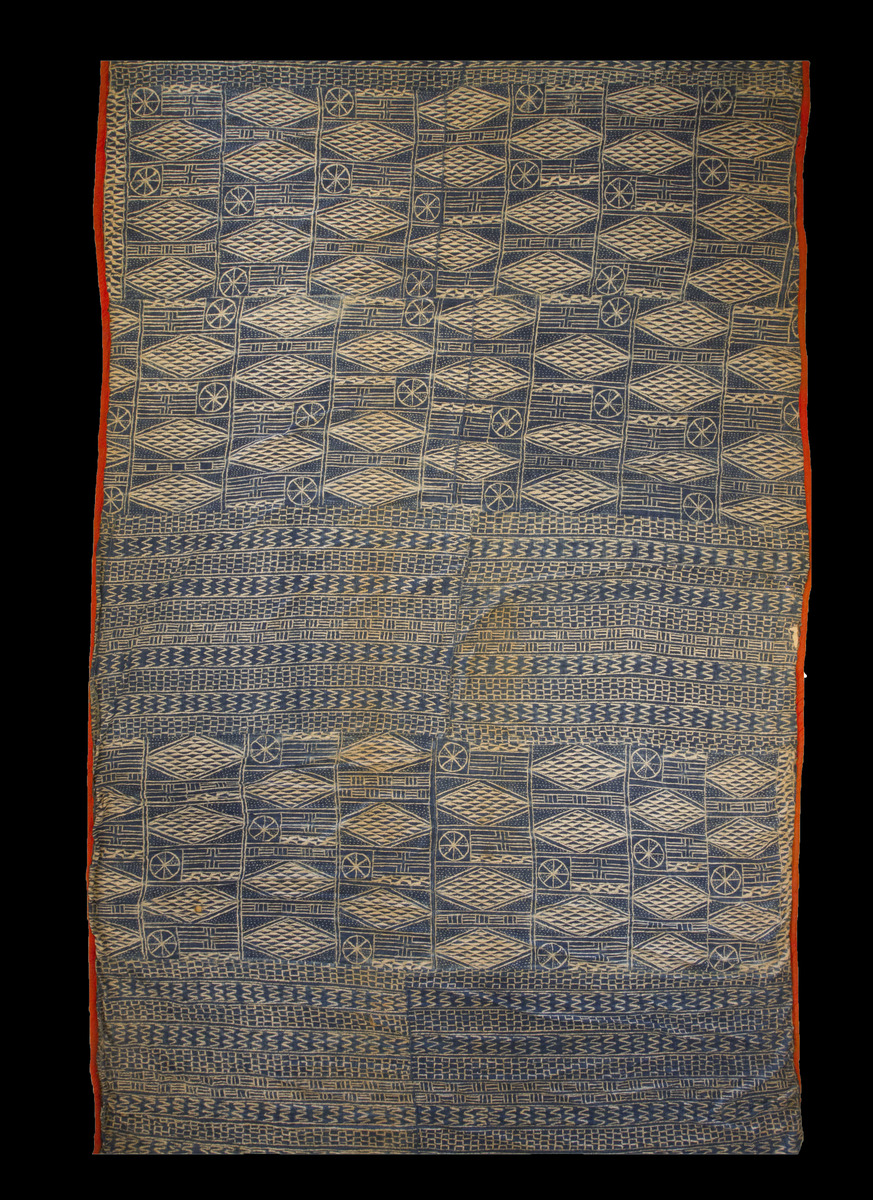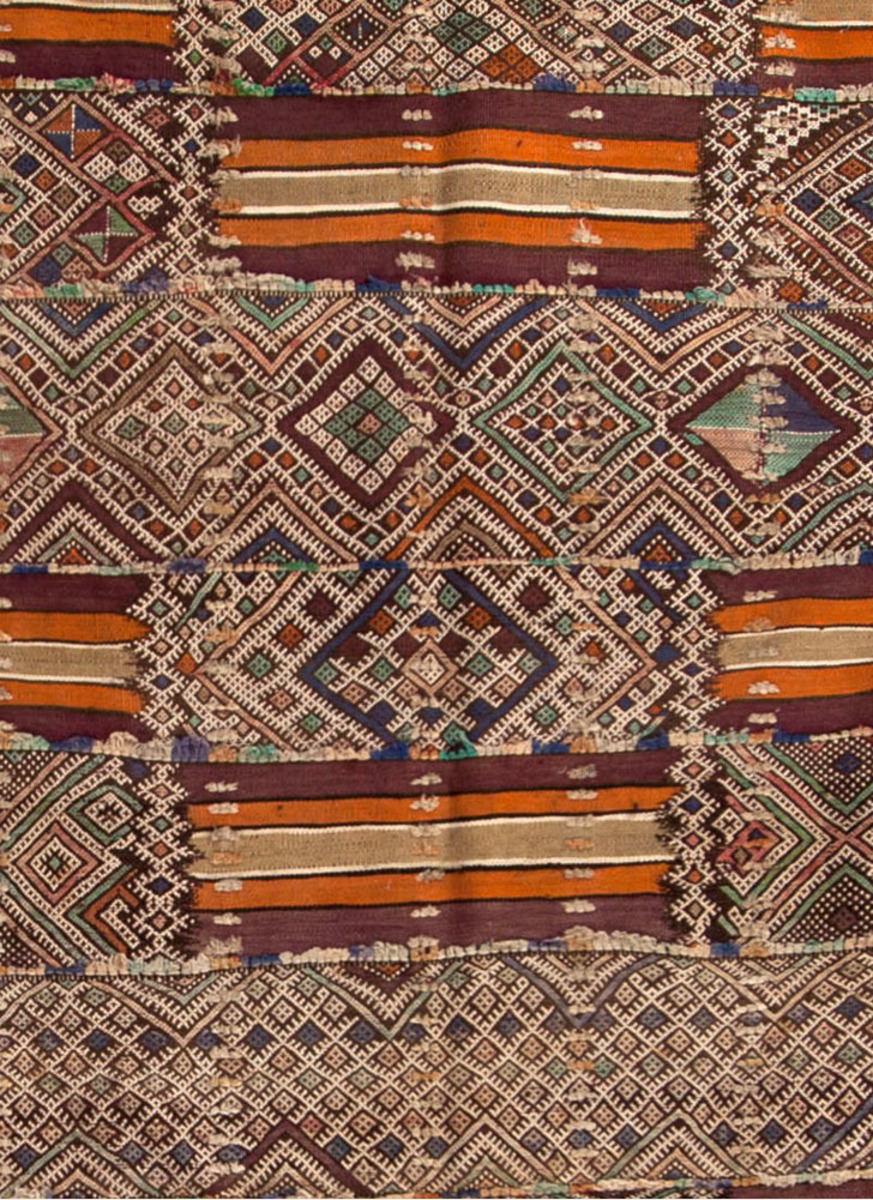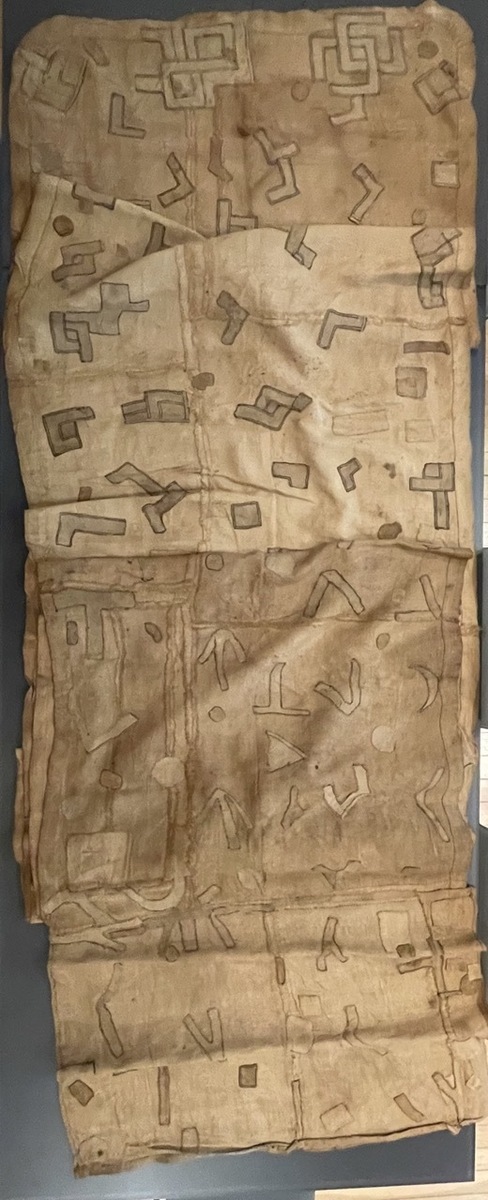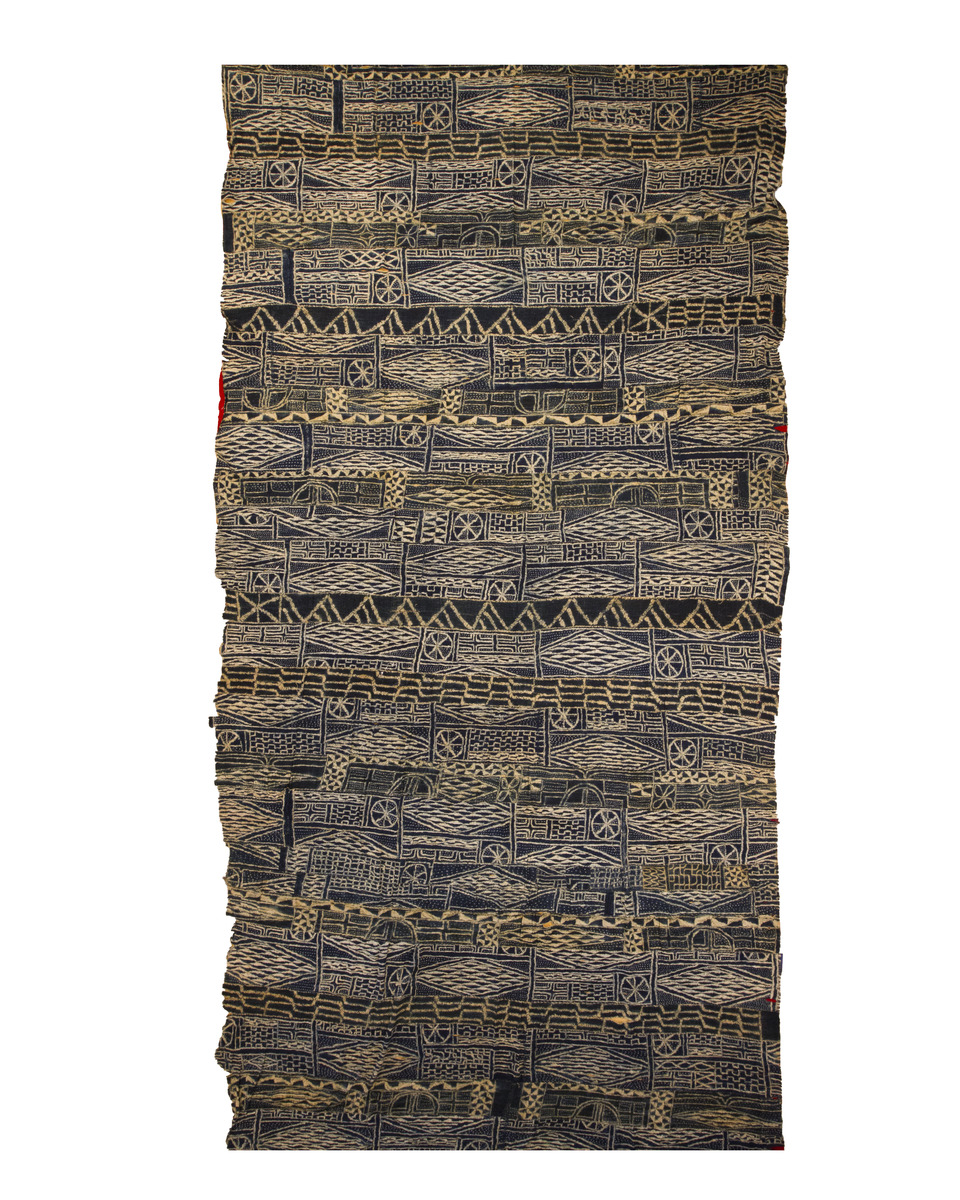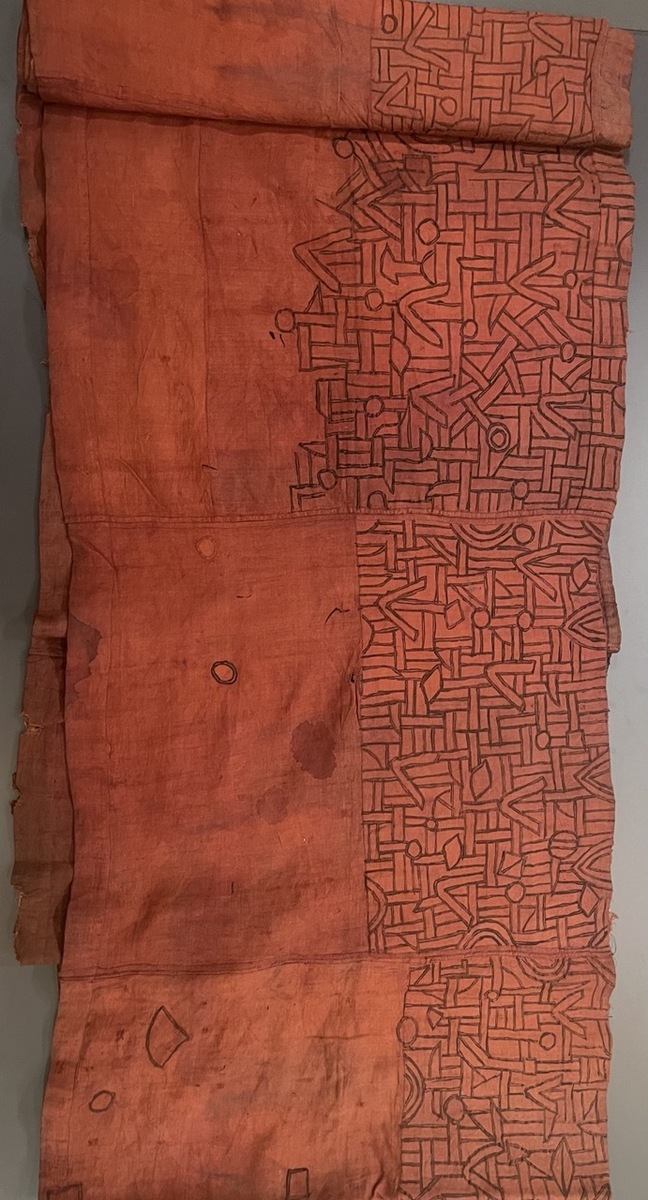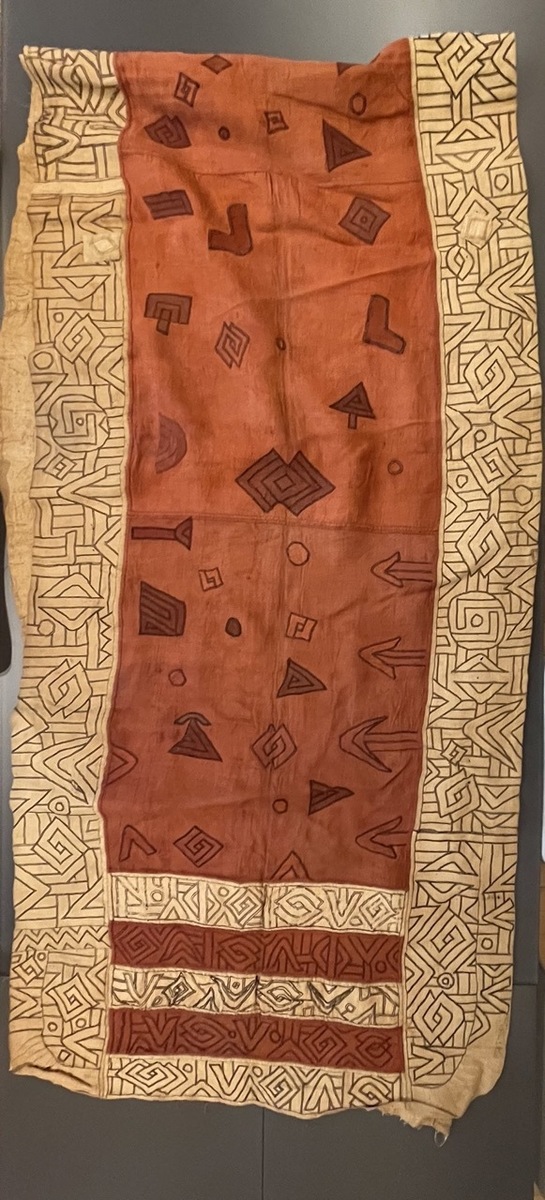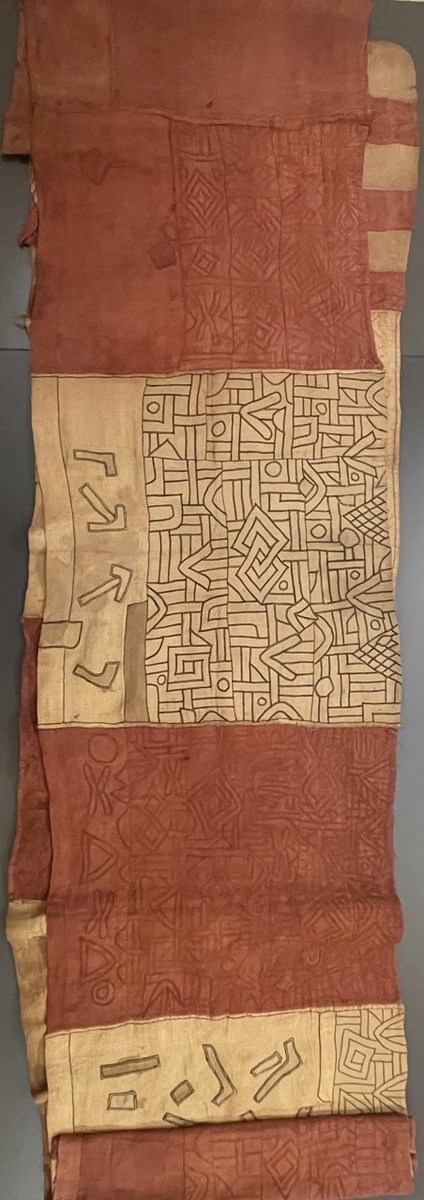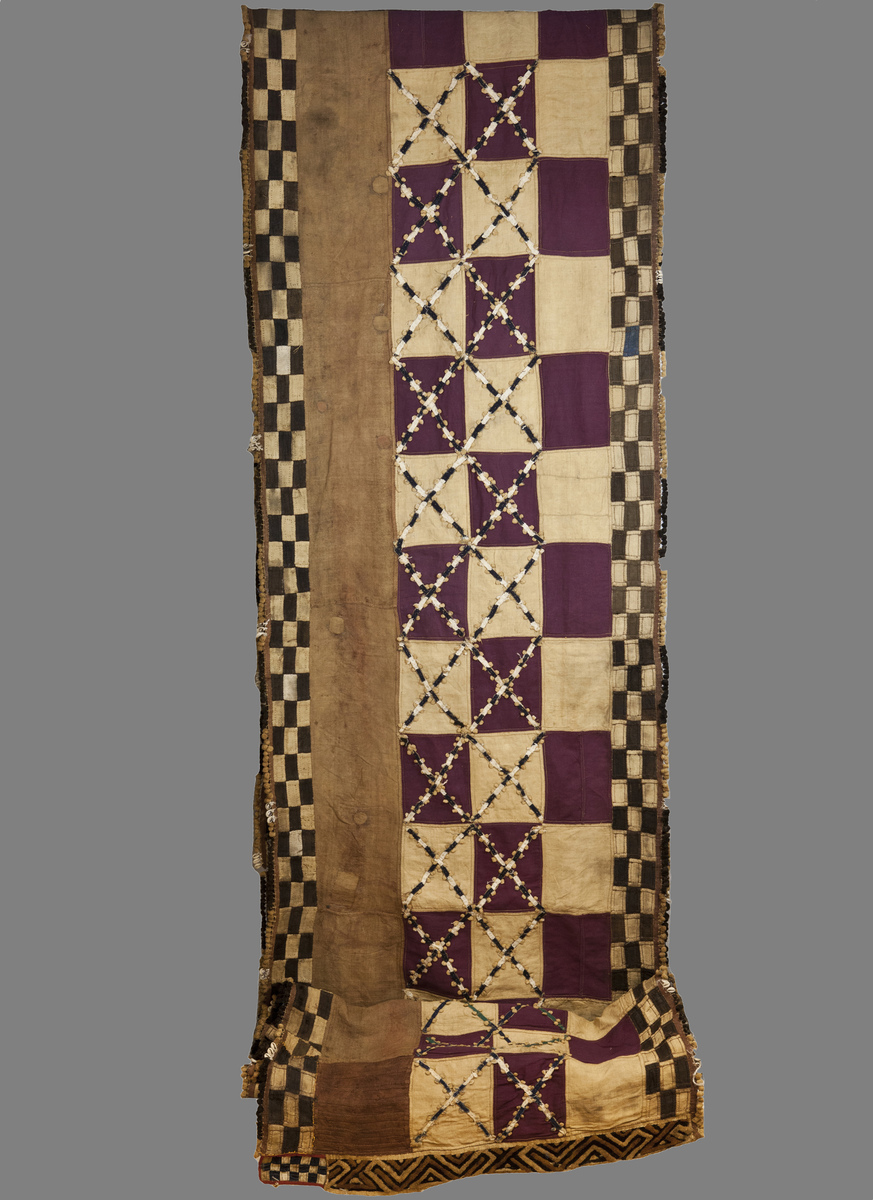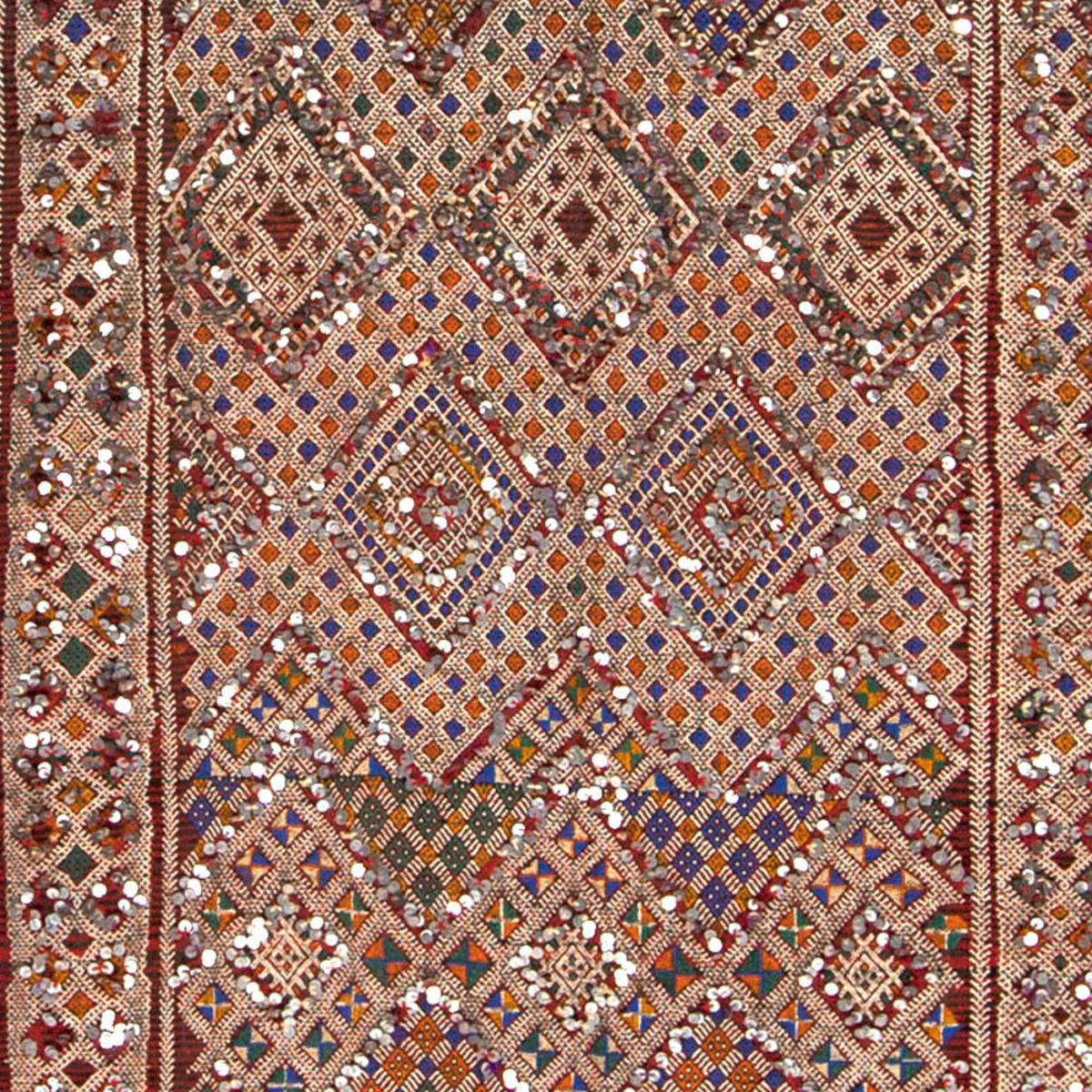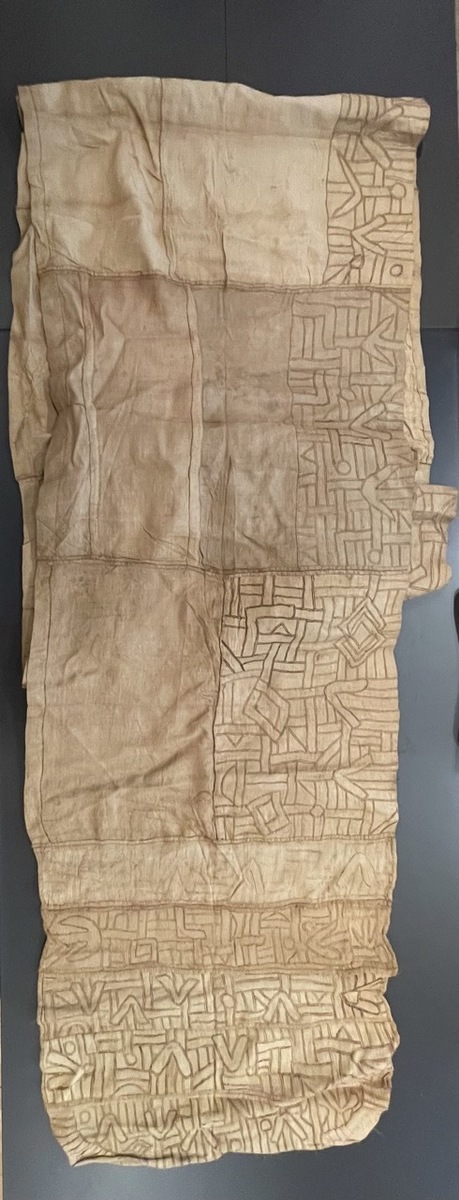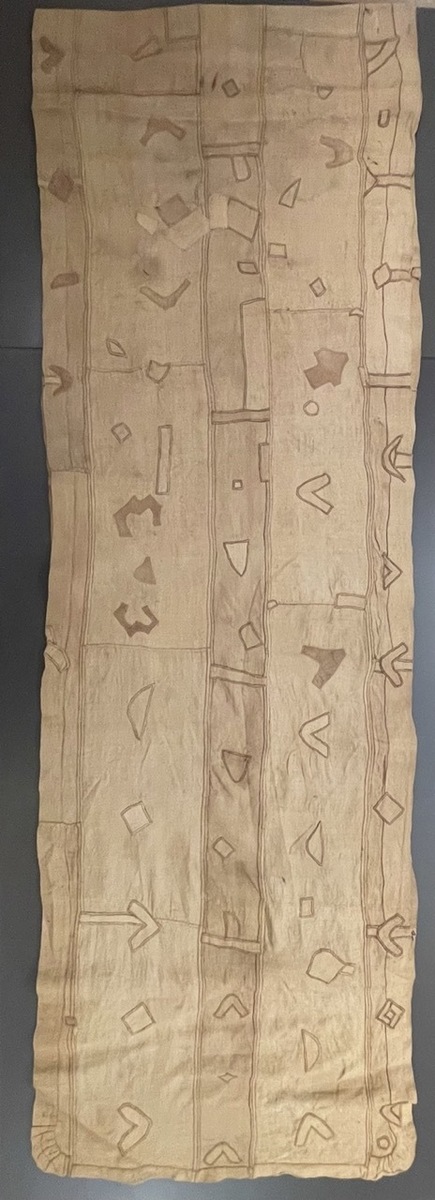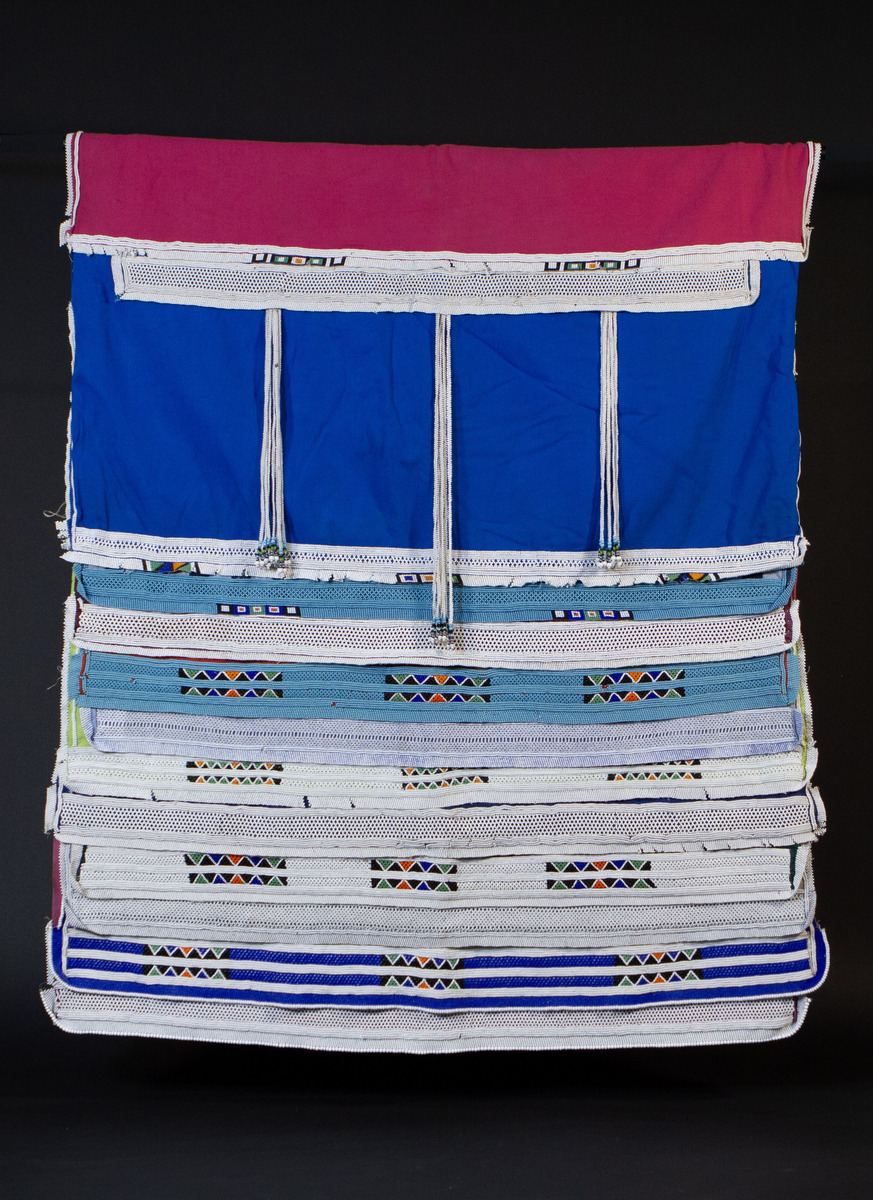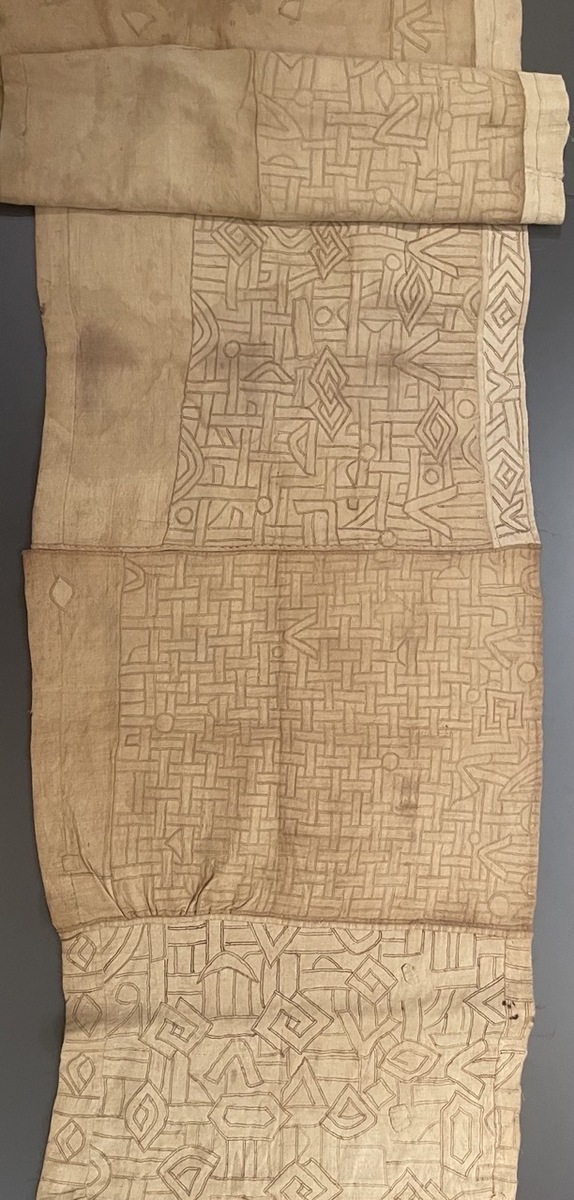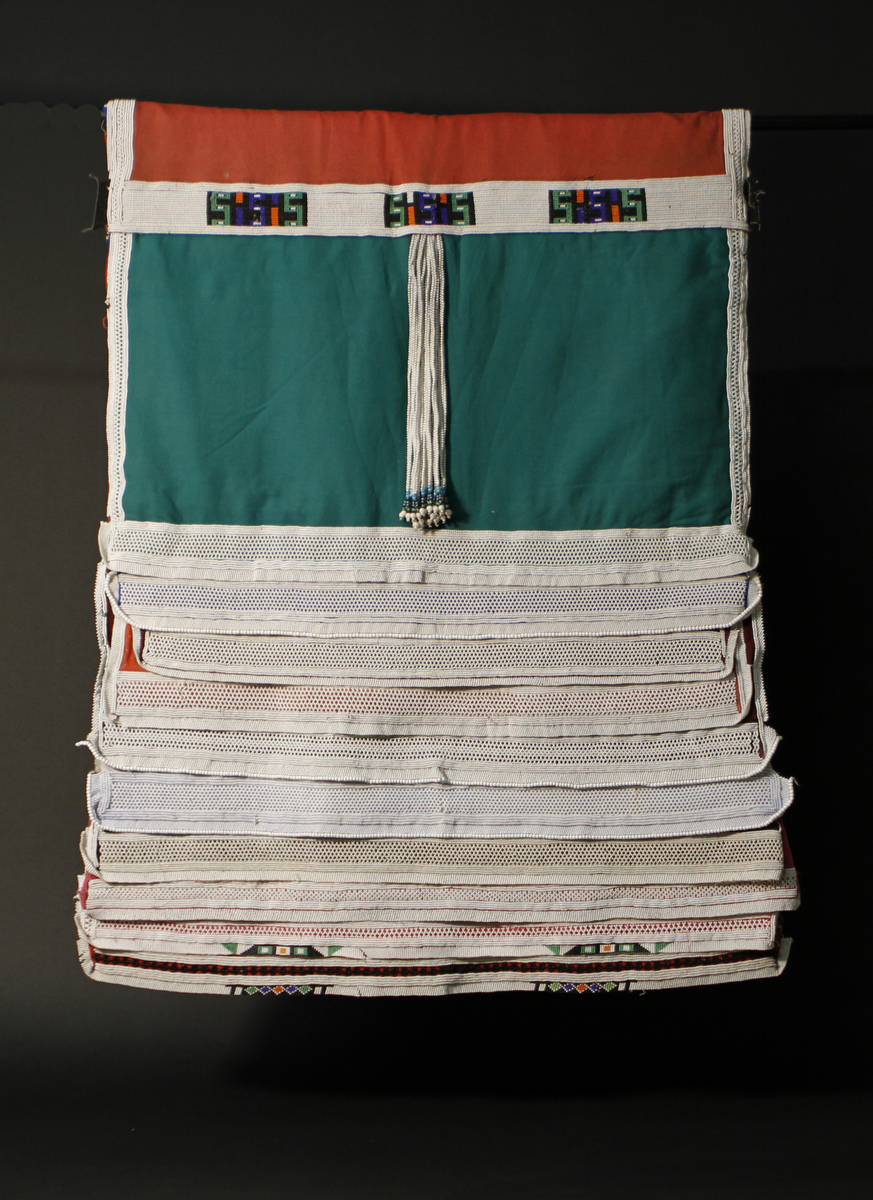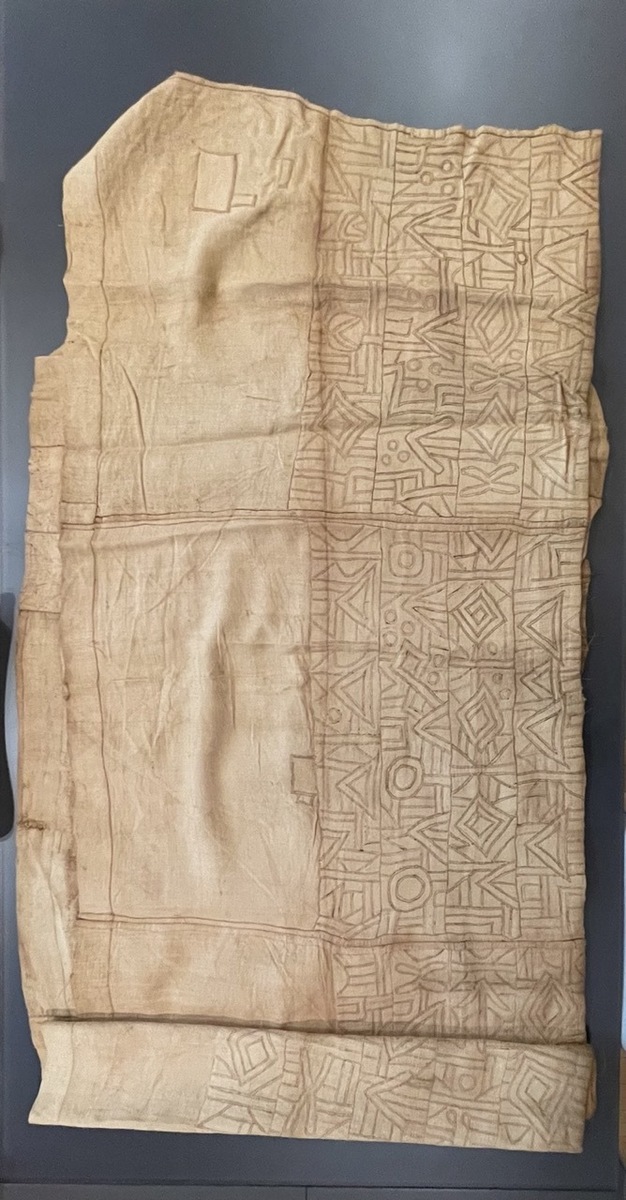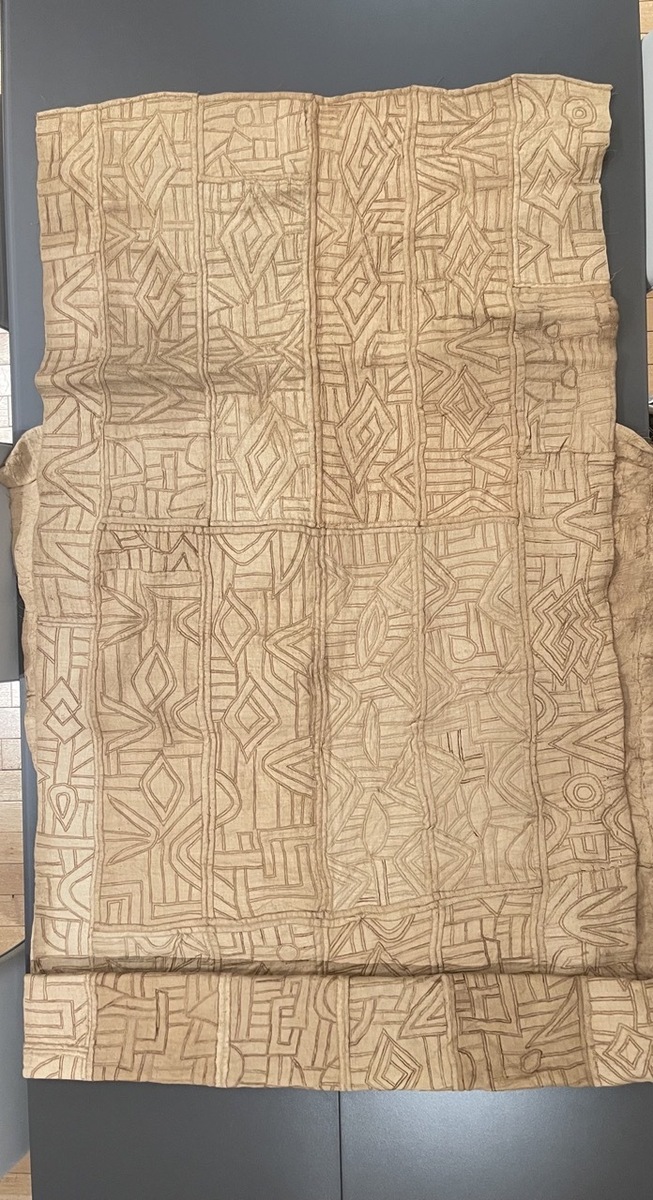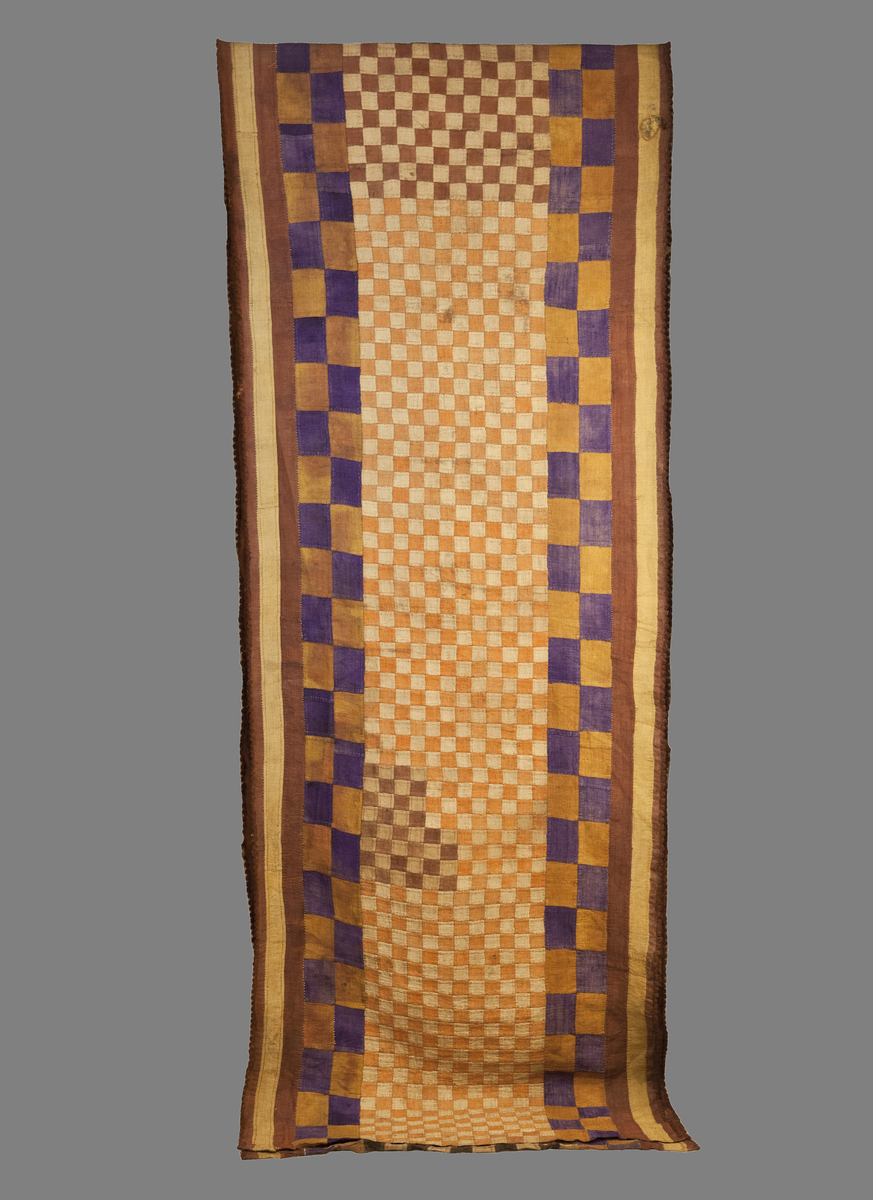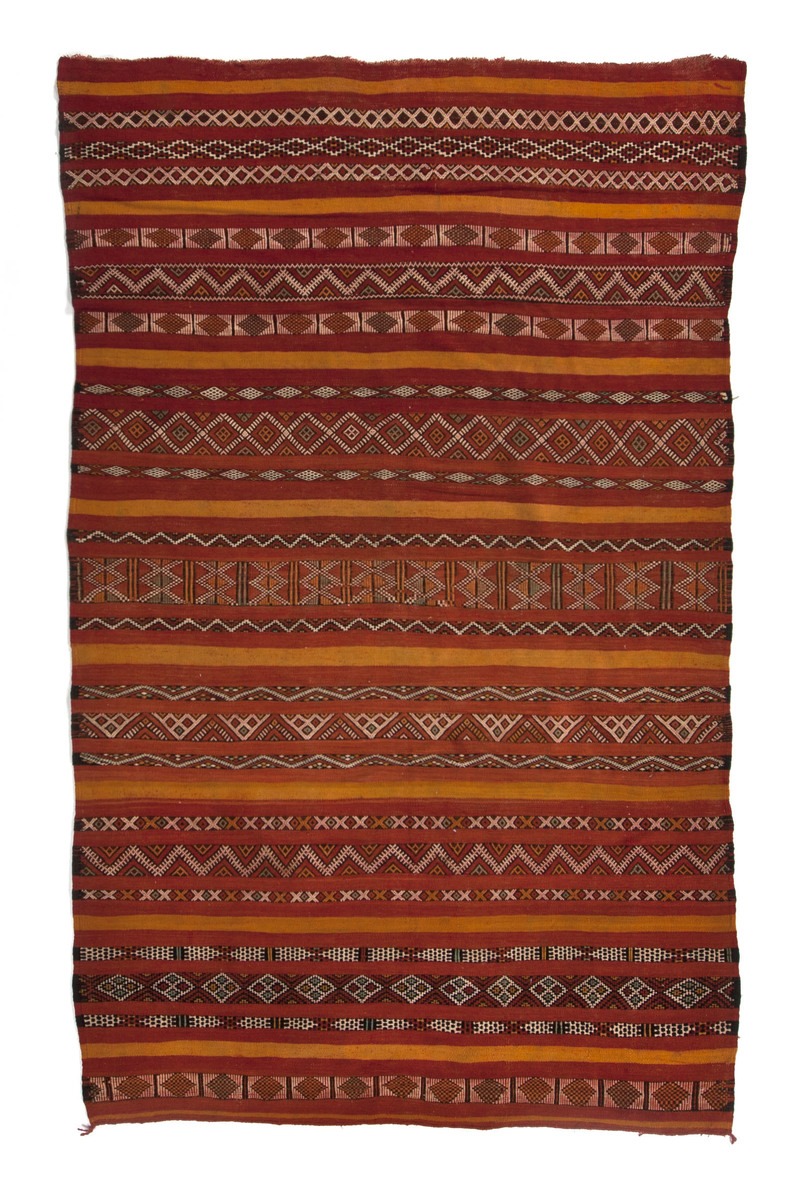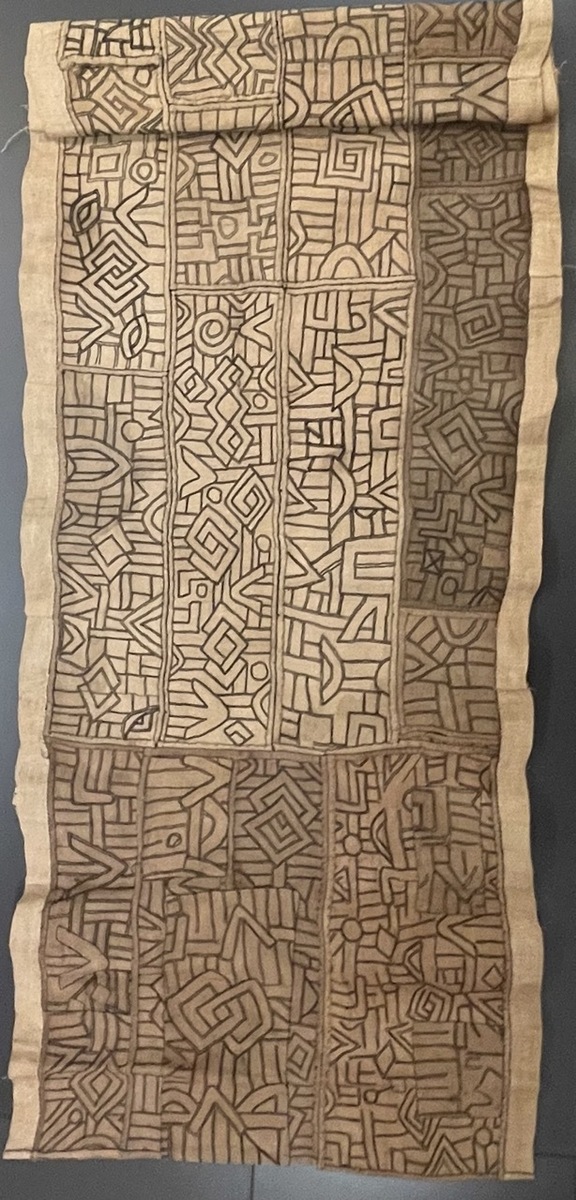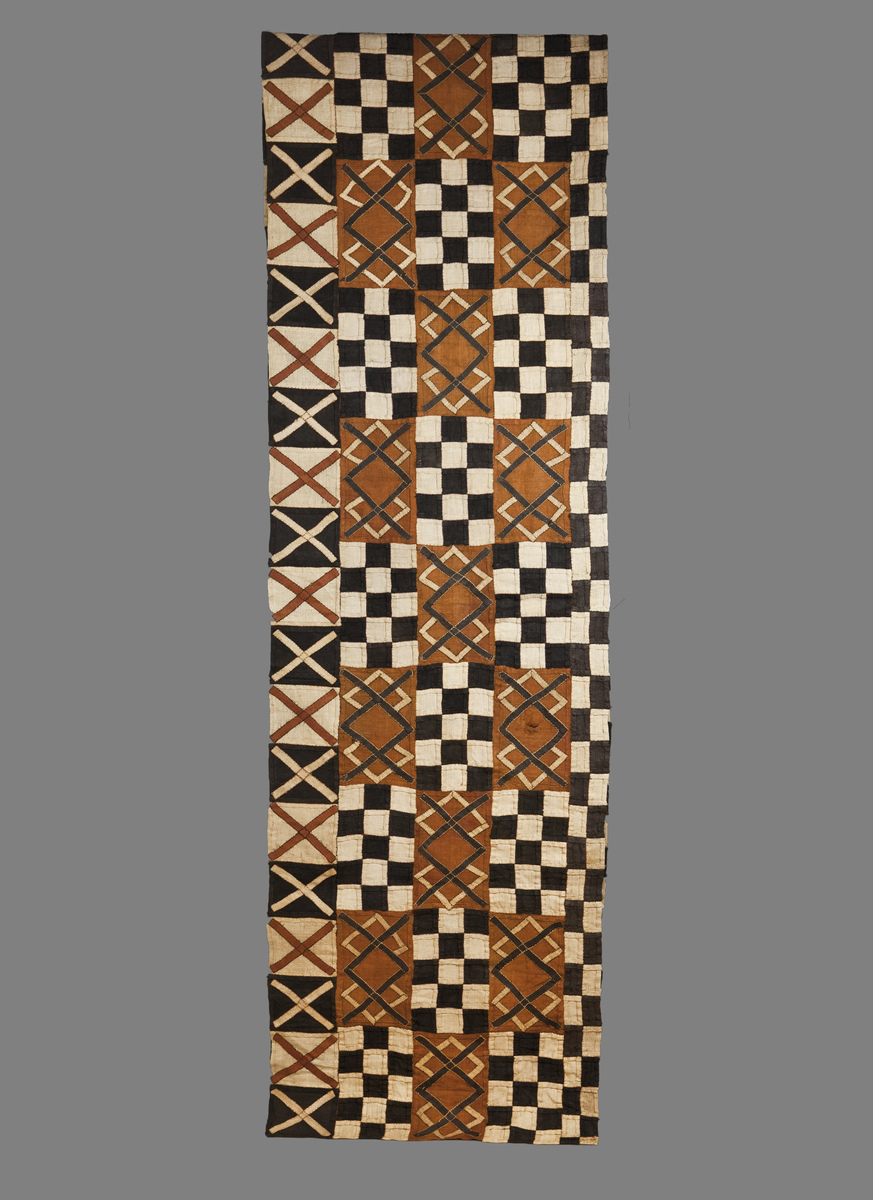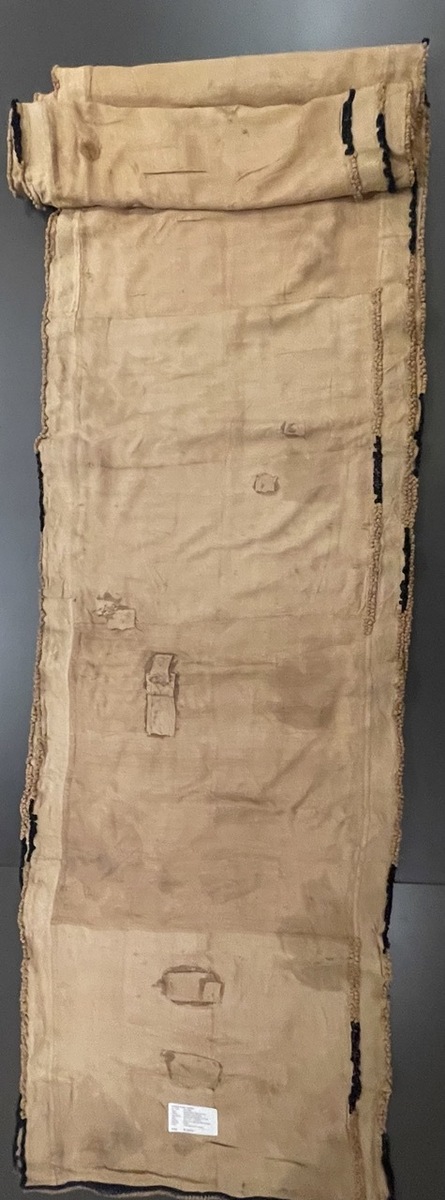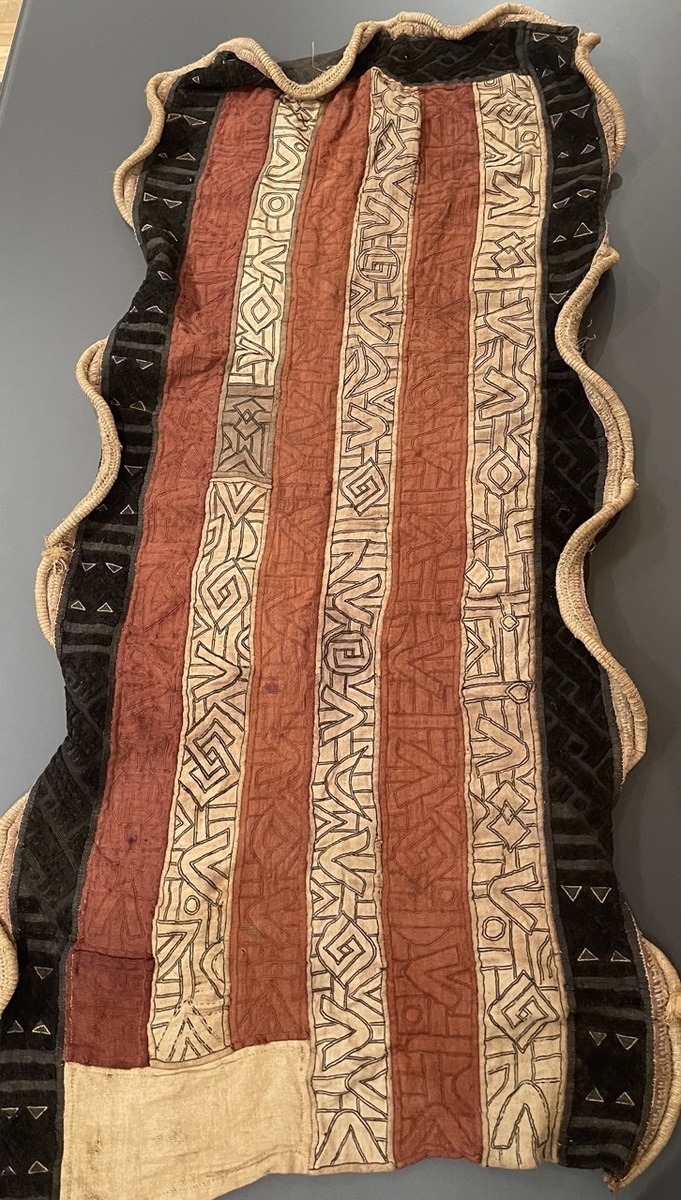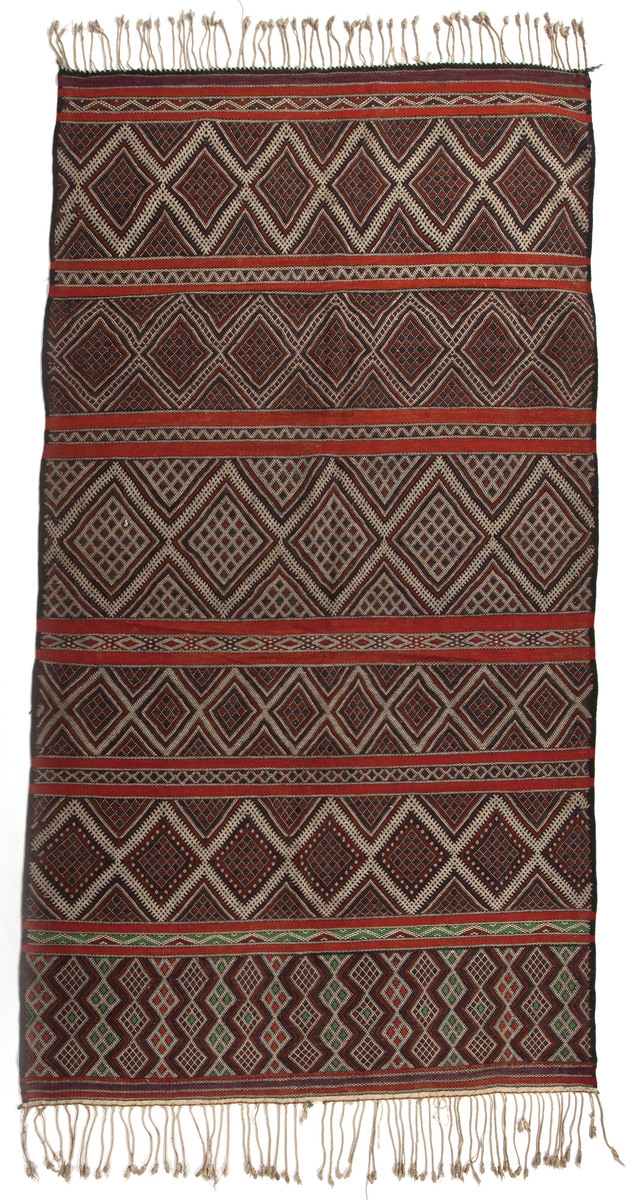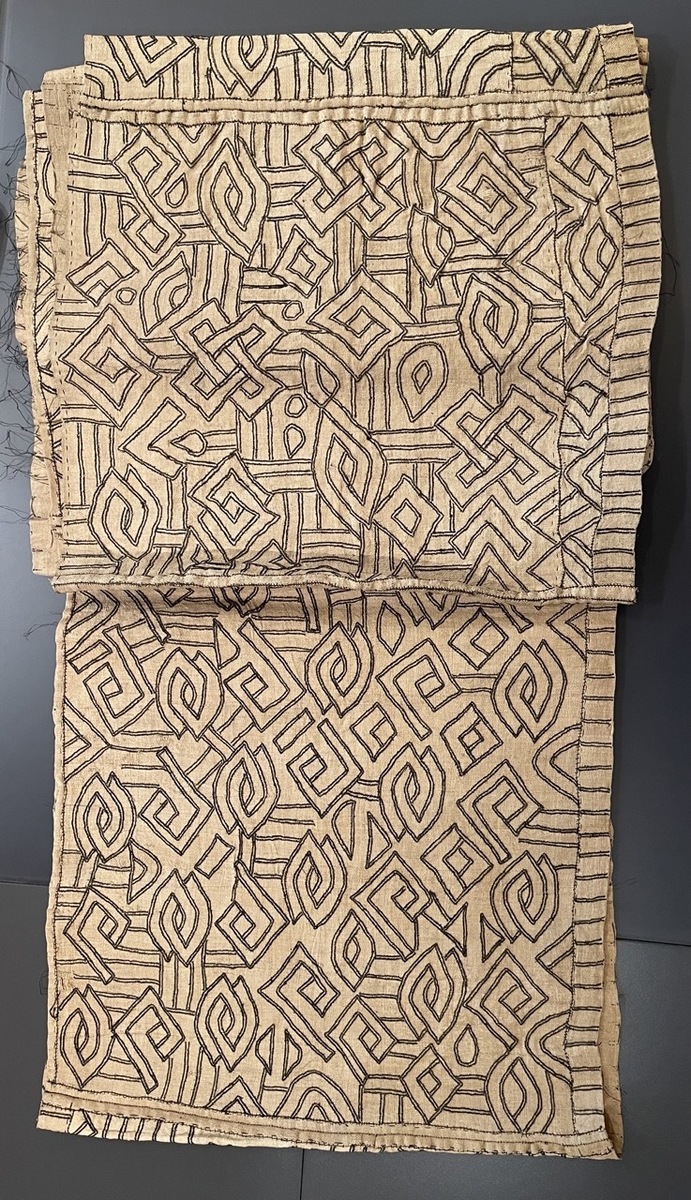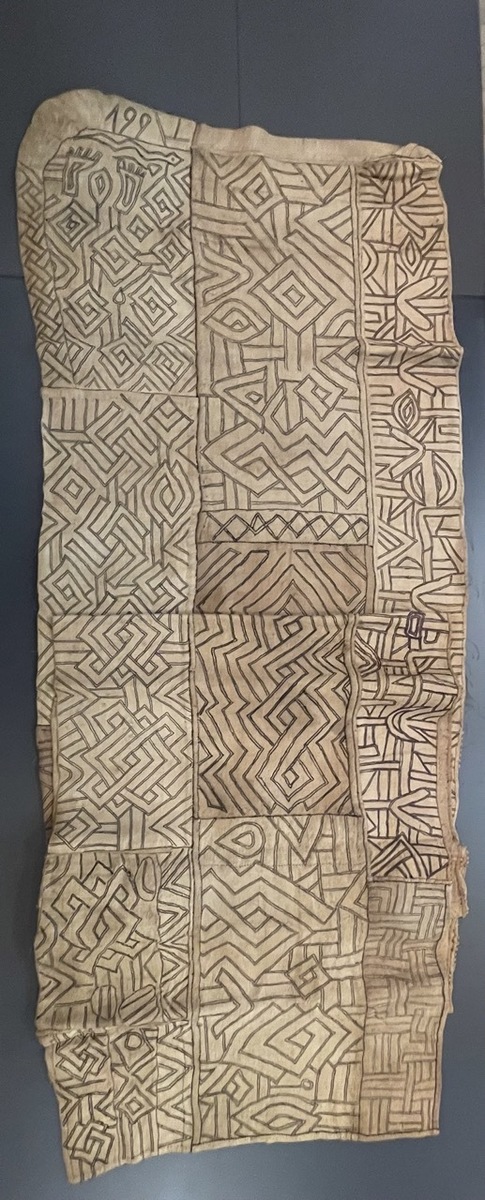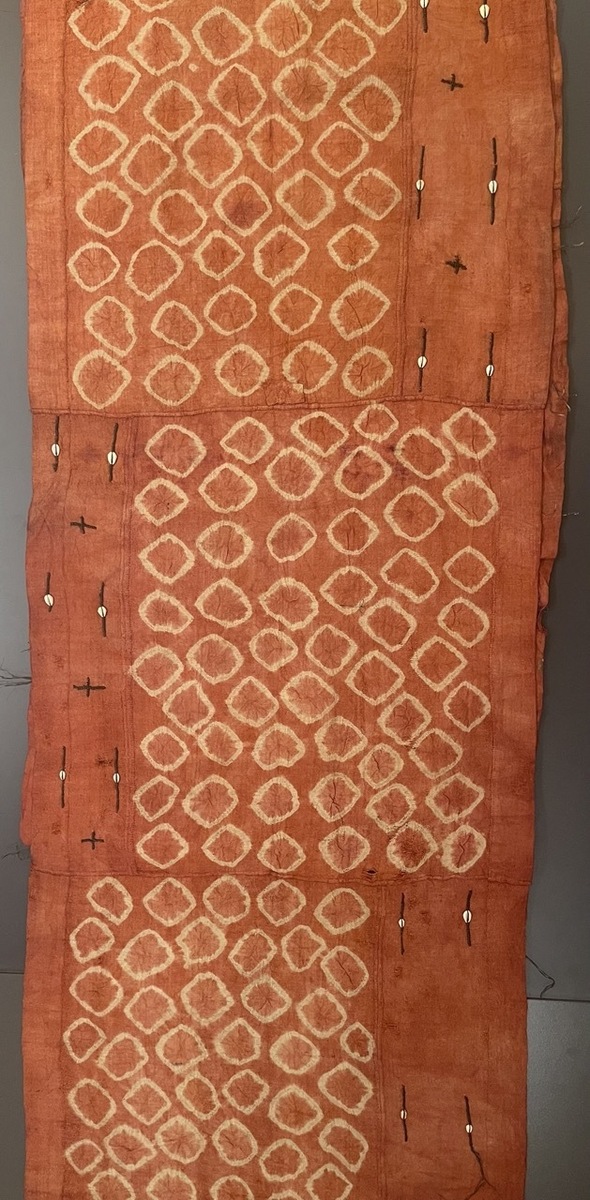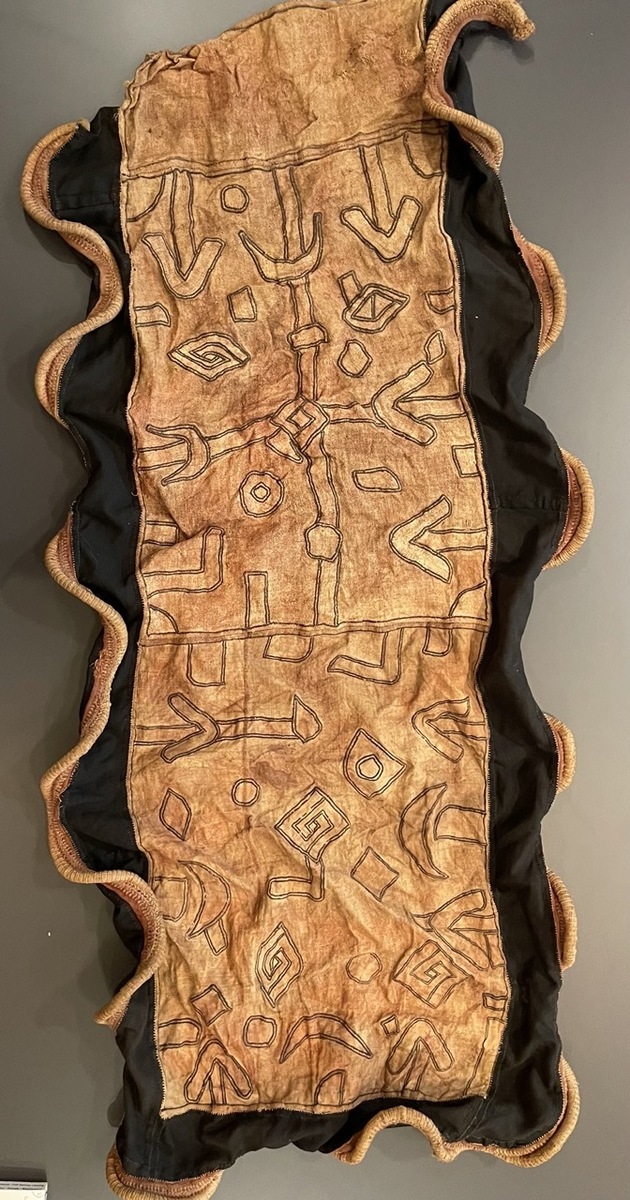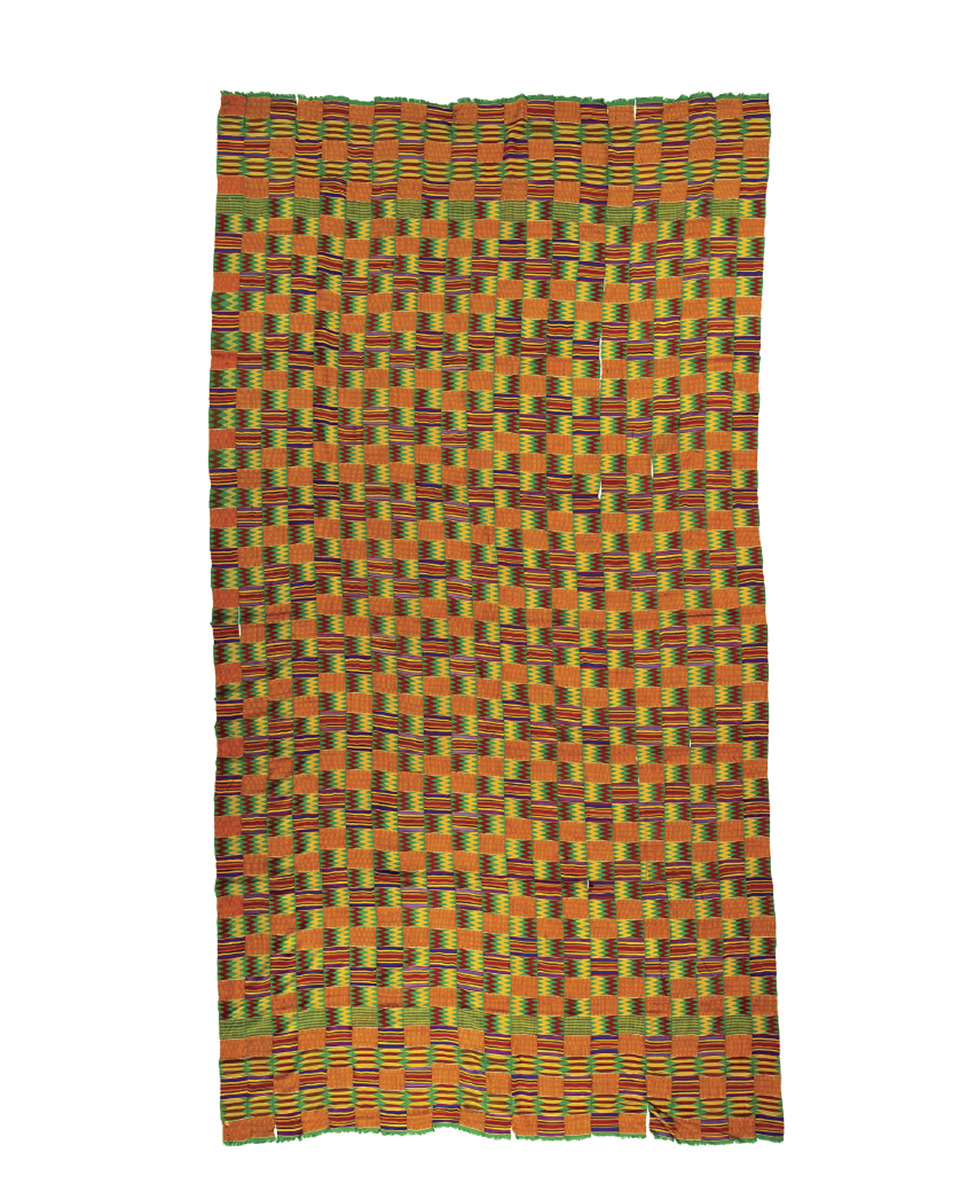Description
A section of the Bushoong Kuba textile skirt, highlighting its intricate geometric appliqué motifs in red, black, and tan. The expansive Bushoong ceremonial skirt is composed of numerous rectangular raffia panels, each individually decorated and then expertly joined lengthwise into a magnificent wrap-around cloth. The visible design is a kinetic patchwork of bold geometric motifs: maze-like labyrinthine patterns in dark embroidery thread beside panels embellished with floating shapes of red and black on a tan field. The Kuba artisan’s mastery of appliqué is on full display – abstract forms in russet red and deep brown/black are cut freehand and stitched onto contrasting backgrounds, their edges defined by neat lines of stitching
artic.edu
. These appliquéd shapes (some resembling interlocking crosses and angular spirals) seem to “float” above the surface, adding a sense of lightness and movement
artic.edu
. In other areas, dense linear embroidery in black creates meandering fretwork and interlace patterns, including classic Kuba motifs like the double-cross Woot pattern symbolizing their ancestral founder
micromacrotextiles.net
. The interplay of light and dark, matte raffia and raised appliqué, gives the skirt a dynamic visual rhythm. A vivid red fabric binding frames the piece along the edges, both protecting the textile and accentuating the overall color palette. The color scheme of warm tan, ebony black, and crimson red is distinctive to Bushoong aesthetic sensibilities, providing striking contrast and graphic boldness. This palette not only creates a dramatic decorative effect but also may signify the prestige of its owner – in Kuba culture such colors (especially the use of rare red dyes) were often associated with high rank and status
theethnichome.com
. Overall, the skirt’s design is a harmonious yet non-repetitive arrangement: each panel’s pattern is unique, but together they form a balanced tapestry of Kuba identity and artistry, with an almost modernist abstraction that belies its traditional origin
noaliving.com
. This textile isn’t just visually stunning; it embodies deep cultural significance for the Kuba people, especially the Bushoong subgroup renowned as the kingdom’s ruling lineage. Among the Kuba, sumptuous raffia cloths like this were symbols of wealth, prestige, and social identity
noaliving.com
. Historically, only persons of high social rank or royal affiliation could commission and wear such elaborate skirts as part of ceremonial attire. Kuba men were responsible for weaving the long strips of raffia cloth, but it was the Kuba women – often several from the same family – who collaboratively transformed those panels into art, hand-embroidering and appliquéing them with imaginative motifs
artic.edu
en.wikipedia.org
. In fact, to create a skirt of this size and complexity, multiple women would each work on different panels, a cooperative process that could take months or years and reflected the Kuba value of communal creativity
en.wikipedia.org
en.wikipedia.org
. The finished skirt, assembled from the many contributors’ panels, thus became a unifying symbol of family and clan identity, with each segment carrying the signature of an individual artist yet merging into a cohesive whole. The abstract geometric designs are often imbued with layered meanings: some patterns are said to represent stylized beings, plants, or objects – effectively an “encrypted” visual script that conveys Kuba heritage and status to those who know how to read it
artic.edu
. Even without literal interpretation, the overall design speaks to a legacy of refined aesthetic principles passed down through generations. The Bushoong and related Kuba clans developed a sophisticated visual language in textiles, favoring techniques of contrast – cut-pile plush vs. flat weave, light vs. dark hues, linear grids vs. organic shapes – to delight the eye. Notably, they avoid a simple repeated pattern; instead, the composition is deliberately varied and off-beat, much like an improvised melody, demonstrating an artistic philosophy that celebrates variation and surprise in rhythm
en.wikipedia.org
en.wikipedia.org
. Such ceremonial skirts (known as ntshak in the Kuba language) were integral to important occasions. They were worn wrapped around the waist and hips, often layered over a plain red or white raffia under-skirt
en.wikipedia.org
, and secured with a belt in a dramatic spiral drape around the body
theethnichome.com
. High-ranking women would wear these prestigious overskirts during dances, funerals, and festivals; for example, at the royal Itul celebration held by the nyim (king), the king’s wives and daughters performed in sumptuous Bushoong skirts like this, their movements enhancing the textile’s dazzling display of pattern and color
theethnichome.com
theethnichome.com
. The skirt’s appliquéd shapes and embroidered lines would catch the eye as the wearer moved, the “lateral motion” of the sewn panels creating a mesmerizing, almost cinematic effect
noaliving.com
. Beyond their role in attire, these textiles also functioned as a form of wealth: historically Kuba ceremonial cloths were given as tribute, used as dowry and currency, and treasured as heirlooms
noaliving.com
. Gifting or displaying such a skirt cemented social bonds and proclaimed the status of both giver and receiver. Over time, fine examples made their way into the outside world; this particular piece, collected in Kinshasa in the mid-20th century, testifies to the enduring allure of Kuba craftsmanship in the broader Congo region and beyond. Display and Legacy: Today, a vintage Bushoong Kuba skirt like this is appreciated not only as wearable regalia but as a work of textile art. Its presence in the home or gallery brings with it the story of a culture where art, community, and prestige are interwoven. Collectors and interior designers admire Kuba textiles for their graphic sophistication and earthy elegance – attributes that allow these pieces to complement contemporary decor as readily as they once lit up royal courts. Indeed, with their bold geometric abstraction and masterful execution, Kuba raffia cloths are “an ancient craft with a surprisingly modern aesthetic”
noaliving.com
. This skirt’s striking red, black, and tan patterns can anchor a space as a wall hanging or draped textile, offering a conversation piece rich in history. Owning it means stewarding a tangible piece of the Kuba legacy, one that celebrates the artistry of Bushoong women and the regal traditions of the Congo. In a retail collection, it stands as a compelling centerpiece – authentic, storied, and visually arresting – inviting viewers to appreciate the fusion of ethnographic significance and aesthetic beauty. References: Hilu, Sam. Textile Art of the Bakuba: Velvet Embroideries in Raffia. New York: Schiffer Publishing, 2002. (See especially for pattern motifs and cultural context.)

